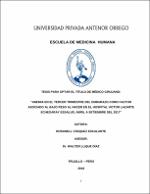| dc.contributor.advisor | Llique Díaz, Walter | |
| dc.contributor.author | Vázquez Escalante, Rosanell | |
| dc.creator | Vázquez Escalante, Rosanell | |
| dc.date.accessioned | 2018-04-16T15:12:22Z | |
| dc.date.available | 2018-04-16T15:12:22Z | |
| dc.date.issued | 2018 | |
| dc.identifier.uri | https://hdl.handle.net/20.500.12759/4011 | |
| dc.description.abstract | INTRODUCCIÓN: El embarazo constituye una de las etapas de mayor vulnerabilidad nutricional y tiene un efecto determinante en el crecimiento fetal y su peso.
Según la Organización Mundial de la Salud (OMS), el bajo peso al nacer es ‹ 2,500 g y es el índice predictivo más importante de mortalidad infantil, y la anemia en el embarazo es ‹11g/dl, y se asocia fundamentalmente con factores relacionados a la deficiencia de hierro, con pobres condiciones de vida y hábitos nutricionales deficientes.
El estado del hierro del feto y del recién nacido dependen de la condición del hierro en la madre gestante; y, en consecuencia, su deficiencia en la futura madre significa que el feto en crecimiento también puede presentarla; pues éste mineral es esencial para el desarrollo y crecimiento normales de la mayoría de los órganos en el feto, especialmente de los órganos hematopoyéticos; y principalmente del cerebro afectando el desarrollo cognitivo, motor, social, emocional y neurofisiológico de las funciones cerebrales, así como valores más bajos en el cociente intelectual en comparación con los infantes y niños.
OBJETIVO: Determinar si la anemia en el tercer trimestre del embarazo es factor asociado al bajo peso al nacer.
MATERIAL Y MÉTODO: Es un estudio analítico, retrospectivo, transversal y observacional, de casos y controles. La muestra se obtuvo por Muestreo– no probabilístico por conveniencia, donde se revisaron las historias clínicas que cumplían con los criterios de inclusión y exclusión, entre los meses abril - septiembre del 2017.
RESULTADOS: Se halló 5.2% de recién nacidos con bajo peso al nacer, La mayor cantidad de gestantes anémicas está en el grupo etáreo de 10 y 20 años , en una prevalencia del 66.7%, De las 536 gestantes a término, el 22.4% y el 11.8% ,presentan anemia leve y moderada, respectivamente ,sumando un total de 34.2%, Para la asociación entre las gestantes anémicas a término y el bajo peso al nacer, ,aplicamos la prueba de Chi cuadrado de Pearson, obtuvimos un P-valor de 0.857 mayor de P‹ 0.05 y para estimar el riesgo de bajo peso al nacer se generó un P- valor de 1.076 y un intervalo de confianza de 95%(IC: 0.486 –2.381).
CONCLUSIÓN: La anemia del tercer trimestre no es un factor de riesgo asociado al bajo peso al nacer. | es_PE |
| dc.description.abstract | INTRODUCTION: Pregnancy is one of the stages of greatest nutritional vulnerability and has a determining effect on fetal growth and weight.
According to the World Health Organization (WHO), low birth weight is <2,500 g and is the most important predictive index of infant mortality, and anemia in pregnancy is <11 g / dl, and is mainly associated with factors related to iron deficiency, with poor living conditions and poor nutritional habits.
The iron status of the fetus and the newborn depend on the condition of the iron in the pregnant mother; and, consequently, its deficiency in the future mother means that the growing fetus can also present it; for this mineral is essential for the normal development and growth of most organs in the fetus, especially the hematopoietic organs; and mainly of the brain affecting the cognitive, motor, social, emotional and neurophysiological development of brain functions, as well as lower values in the IQ compared to infants and children.
OBJECTIVE: To determine if anemia in the third trimester of pregnancy is a factor associated with low birth weight.
MATERIAL AND METHOD: This study is analytical, cross-sectional and observational retrospective of cases and controls, the sample was obtained by non-probabilistic sampling for convenience, where the clinical records that met the inclusion and exclusion criteria were reviewed, between April to September 2017.
RESULTS: 5.2% of newborns with low birth weight were found. The greatest number of anemic pregnant women is in the 10 and 20 year old age group, in a prevalence of 66.7%, of the 536 pregnant women at term, 22.4% and 11.8% presented mild and moderate anemia, respectively, adding up to a total of 34.2%. For the association between pregnant anemics at term and low birth weight, we applied the Pearson Chi square test, we obtained a P-value of 0.857 greater than P <0.05 and to estimate the risk of low birth weight, a P-value of 1.076 and a confidence interval of 95% (CI: 0.486 -2.381) were generated | en_US |
| dc.description.uri | Tesis | es_PE |
| dc.format | application/pdf | es_PE |
| dc.language.iso | spa | es_PE |
| dc.publisher | Universidad Privada Antenor Orrego - UPAO | es_PE |
| dc.relation.ispartofseries | T_MED.HUMA_2275 | |
| dc.rights | info:eu-repo/semantics/openAccess | es_PE |
| dc.source | Universidad Privada Antenor Orrego | es_PE |
| dc.source | Repositorio Institucional - UPAO | es_PE |
| dc.subject | Anemia en el tercer trimestre | es_PE |
| dc.subject | Bajo peso al nacer | es_PE |
| dc.title | Anemia en el tercer trimestre del embarazo como factor asociado al bajo peso al nacer en el Hospital Víctor Lazarte Echegaray EsSalud, abril a setiembre del 2017 | es_PE |
| dc.type | info:eu-repo/semantics/bachelorThesis | es_PE |
| thesis.degree.level | Título Profesional | es_PE |
| thesis.degree.grantor | Universidad Privada Antenor Orrego. Facultad de Medicina Humana | es_PE |
| thesis.degree.name | Médico Cirujano | es_PE |
| thesis.degree.discipline | Medicina Humana | es_PE |

